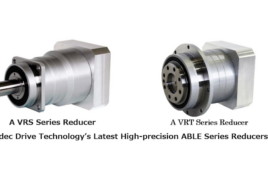Trio Motion has introduced a new optional format for its MC403 series motion controller that offers machine builders and designers cost savings whilst maintaining many of the advanced features found throughout its high specification Motion Coordinator range. The entry level MC403-Z removes the built-in DAC that is available with other formats of the MC403 motion controller targeting its control functionality to pulse and direction output for up to three stepper or servo axes – but the flexibility offered by this advanced motion controller allows for many other configuration options.
There are two MC403-Z versions available offering control of two or three axes. The ‘core axis’ connections on the MC403–Z can be configured as pulse and direction outputs to drives, or as incremental encoder feedback inputs, or simulated encoder outputs. The MC403-Z three axis variant allows one axis to be set-up as an ‘extended axis’ where the connection may also be configured as an input for SSI, Tamagawa or EnDAT absolute encoders. This flexibility means that users can tailor the controller to their machine requirements. Machine designs could, for instance, use the MC403-Z for simple two or three axis open-loop stepper systems and two or three axis servo systems – providing position and speed as a pulse and direction output (with the servo drive closing the loop). Alternatively, the MC403-Z may synchronise axes from an incremental or absolute encoder or utilise its simulated encoder output which can be used to time external events.
In combination with the MC403-Z’s powerful 64 bit ARM11 processor, generous digital and analogue I/O count and numerous other advanced features including built-in Ethernet and the ability to add robotic transformations or synchronise motion with double floating point precision, this flexibility allows for a wide and cost effective choice of machine design for low axis count machines where precision and high performance are paramount. With multiple high speed registration input capability and hardware linked outputs, the controller will find applications in high throughput production equipment such as labelling and packaging machines, laser machining or camera based high-accuracy positioning systems, parallel arm robots and much more. MC403-Z applications can also benefit from CANopen I/O expansion as well as the UNIPLAY HMI touch screen display that is programmed directly within Trio Motion’s Motion Perfect v3 (MPv3) application development, configuration and connectivity software – saving time, cost and effort for product development. Functionally the controller can undertake linear, circular, helical and spherical interpolation across all axes as well as flexible CAM shapes and linked motion. Its ARM11 Processor with Vector Floating-Point (VFP) also provides the ability for complex arithmetic operations making process-centric machine control possible.
The controller has eight 24 VDC digital inputs including six 20 µsec registration inputs, and four 24 VDC bi-directional I/Os. Two 12 bit analogue inputs are also included and modular CANopen I/O expansion extends to 512 digital I/O points, 32/16 analogue inputs/outputs at 12 bit resolution. An RJ45 Ethernet port is provided for programming and connection of HMI or other devices. Communication protocols available include DeviceNet, CANopen, Modbus TCP/IP, Ethernet IP and Ethernet (10/100) base T. An RS232/485 serial port is also provided for communications or for use with Modbus-RTU, Hostlink or user programmable devices. Memory expansion with a Micro SD card slot also allows program and configuration data transfer across machines.
The MC403-Z uses the same powerful multi-tasking TrioBASIC or the optional IEC61131 programming that is used throughout Trio Motion’s Motion Coordinator range. All Motion Coordinator’s benefit from free support software including CAD2Motion and G-code interpreters and Trio Motion’s ActiveX utility that allows direct connection to and from host applications using Microsoft’s Visual programming languages.
Trio Motion
www.triomotion.com
Filed Under: Motion Control Tips




